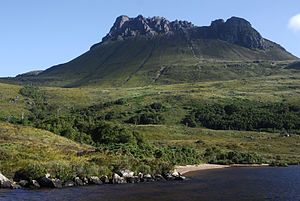Stac Pollaidh: Difference between revisions
Created page with "{{Infobox hill |name=Stac Pollaidh |picture=Stac Pollaidh 3.jpg |picture caption=Stac Pollaidh |height=2,008 feet |os grid ref=NC107106 }} '''Stac Pollaidh''' is a mountain in..." |
mNo edit summary |
||
| (3 intermediate revisions by the same user not shown) | |||
| Line 1: | Line 1: | ||
{{Infobox hill | {{Infobox hill | ||
|name=Stac Pollaidh | |name=Stac Pollaidh | ||
|county=Cromartyshire | |||
|range=Coigach Hills | |||
|picture=Stac Pollaidh 3.jpg | |picture=Stac Pollaidh 3.jpg | ||
|picture caption=Stac Pollaidh | |picture caption=Stac Pollaidh | ||
|height=2,008 feet | |height=2,008 feet | ||
|os grid ref=NC107106 | |os grid ref=NC107106 | ||
|latitude=58.04400 | |||
|longitude=-5.20881 | |||
}} | }} | ||
'''Stac Pollaidh''' is a mountain in the | '''Stac Pollaidh''' is a mountain in the rugged, empty lands of [[Coigach]] in the west of [[Cromartyshire]], close to the edge of [[Sutherland]]. The peak displays a rocky crest of Torridonian sandstone, with many pinnacles and steep gullies. The crest is extremely weathered, more so than other Torridonian peaks, suggesting that it was not covered in ice during the last Ice Age. | ||
The name Stac Pollaidh is a Gaelicization of an Old Norse name, "The pinnacle of the pool river" (''Stakkr Pollå''). It is often anglicised to '''Stack Polly'''. | The name Stac Pollaidh is a Gaelicization of an Old Norse name, "The pinnacle of the pool river" (''Stakkr Pollå''). It is often anglicised to '''Stack Polly'''. | ||
| Line 33: | Line 37: | ||
==References== | ==References== | ||
{{reflist}} | {{reflist}} | ||
* [http://earth.leeds.ac.uk/assyntgeology/extra_info/about_us/project_details.htm ''British Geological Survey: The Moine Thrust Project''] - Geological information from the [[University of Leeds]] | *[http://earth.leeds.ac.uk/assyntgeology/extra_info/about_us/project_details.htm ''British Geological Survey: The Moine Thrust Project''] - Geological information from the [[University of Leeds]] | ||
* | *[http://news.scotsman.com/topics.cfm?tid=747&id=862282004 ''Stac Pollaidh escapes march of the masts''] - ''The Scotsman'' (John Ross, 28 July 2004) | ||
* ''The Grahams'', Andrew Dempster, Mainstream Publishing, ISBN 1-84018-734-4 | *''The Grahams'', Andrew Dempster, Mainstream Publishing, ISBN 1-84018-734-4 | ||
Latest revision as of 20:24, 17 June 2015
| Stac Pollaidh | |||
| Cromartyshire | |||
|---|---|---|---|
 Stac Pollaidh | |||
| Range: | Coigach Hills | ||
| Summit: | 2,008 feet NC107106 58°2’38"N, 5°12’32"W | ||
Stac Pollaidh is a mountain in the rugged, empty lands of Coigach in the west of Cromartyshire, close to the edge of Sutherland. The peak displays a rocky crest of Torridonian sandstone, with many pinnacles and steep gullies. The crest is extremely weathered, more so than other Torridonian peaks, suggesting that it was not covered in ice during the last Ice Age.
The name Stac Pollaidh is a Gaelicization of an Old Norse name, "The pinnacle of the pool river" (Stakkr Pollå). It is often anglicised to Stack Polly.

Due to its relatively low height of just over 2,000 feet, fine views and ease of access from a road, Stac Pollaidh has become a very popular peak to climb. It also provides some fine scrambling in the traverse of the summit ridge, including one bad step near the final summit. Consequentially it has suffered from a great deal of erosion, leading to Scottish Natural Heritage constructing a large path.
Ascent

Stac Pollaidh can be climbed in less than 3 hours by any relatively fit person. From the car park on the shore of Loch Lurgainn the path leads directly up, under the spires of the crest. About 200 yards from the road the path splits; one may choose either since both meet up on the far side of the hill, from where it is only a short distance to the summit ridge.

Once on the ridge the true summit lies about 330 yards to the west. However to reach it one must scramble over several rocky pinnacles, and a good head for heights is required.
The sandstone pinnacles are impressive and are rated in Scotland as second only to the ones on Quiraing on the Isle of Skye. They carry names such as "The Sphinx", "Tam o' Shanter", "Andy Capp" and "Madonna and Child". A particularly fine example known as the "Lobsters Claw" partly collapsed several years ago due to natural erosion.[1]
The lower, eastern, peak can be reached without any difficulty. From any point on the crest there are excellent views of the wide expanse of the Inverpolly Forest, and of neighbouring peaks such as Suilven. The views of the Atlantic Ocean are breathtaking. Returning on the other path allows for a circular walk of about 2 miles.
Outside links
| ("Wikimedia Commons" has material about Stac Pollaidh) |
References
- ↑ "The Grahams" Pages 211 (Gives details of pinnacles).
- British Geological Survey: The Moine Thrust Project - Geological information from the University of Leeds
- Stac Pollaidh escapes march of the masts - The Scotsman (John Ross, 28 July 2004)
- The Grahams, Andrew Dempster, Mainstream Publishing, ISBN 1-84018-734-4
